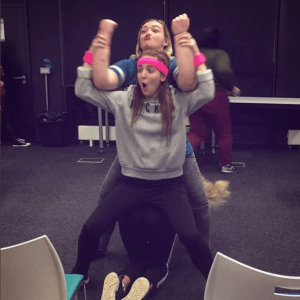With such light heartedness surrounding our theatre company, I grabbed at the chance to create physical comedy with my choreography. I turned to John Wright’s theory that indicates “four different aspects of comedy” (2006, 5), and felt that the most appropriate strand of laughter to generate for The Truth About Bedtime… would be “The Recognised Laugh” where audiences laugh because “they recognise[…] the parody” (Wright, 2006, 7). The scene where this type of comedy became the most apparent came in ‘The Exercise Scene’, where we set the scene of a gym class. We used recognisable, stylised motifs, such as preparing ourselves for the gym class with headbands and sweatbands. It was our hope that these motifs would be easily identified by the audience, whether it be with their selves or with somebody close to them. John Wright states that “recognition is at the heart of the way we represent our humanity on stage”, so although these movements alone arent necessarily funny, comedy is generated through its recognition (Wright, 2006, 9).
Our bodies were also used to create the illusion of exercise machines and we used glow sticks to create glow in the dark exercise bikes, to replicate a spin class.
(Hutchinson, 2018).
This scene also provided us an opportunity to create comedy throughout our faces and bodies. In order for this scene to work, all inhibitions and embarrassments needed to be cast to one side. The aim was to create over the top comedy, again taking these recognisable movements and pushing them to an exaggerated interpretation of them.
L.R.
Works Cited
Hutchinson, E. (2018) Exercise machine [image].
Wright, J. (2006) Why is that so funny? London: Nick Hern Books Limited.
